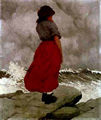With large numbers of the Achill population working overseas for many months of the year, it was perhaps inevitable that Paul Henry's closest contacts on the island would be the older generation such as Johnny Tom Owen MacNamara. It was also, of course, the older generation whose lives more closely approached the simple, peasant Arcadia that Paul Henry sought to visualise in his work. Another Achill local who made a big impression on Paul Henry was Michael Mangan, a elderly cobbler (shoe maker) who died in 1915. Paul Henry described Michael Mangan's living conditions:
... "There was just one miserable room and the cabin ... was falling to pieces from age and neglect. On one side, where it threatened to fall over into the garden, it was shored up with baulks of timber, driftwood picked up on the strand. The one window was about two feet square and was built in and could not be opened, and the only ventilation came through the door which was always open as it helped to lighten the gloom of the interior. The chimney had partly fallen in and the room was always full of smoke. The roof had not been freshly thatched for years ... and the whole thing leaked abominably.
To the left of the ruined hearth stood Michael's bed, just a few planks covered with straw, sheets of brown paper, sacks and old rags and raised a foot or so from the earth floor which often held pools of water from the dilapidated roof."
(Paul Henry, 'An Irish Portrait', pp60-61)
What Paul Henry failed to acknowledge was that Michael Mangan was actually the founder of the Land League on Achill Island and that, in contrast to the image of an elderly peasant whose self-contained world extended no further than Achill Sound, Gaelic-speaking Michael Mangan used to regularly hold meetings in his home in which he would supervise discussions of current events and newspaper articles (reported in Mary Cosgrove, 'Paul Henry and Achill Island').
Just before Michael Mangan's death, Paul Henry had arranged with the old man's landlord, Sir Horace Plunkett, for repairs to be made to his cabin. At that time on Achill, and on landlords' estates across Ireland, tenants paid rent for their land. The construction - and upkeep - of their dwellings was the responsibility of the tenants. However, if any repairs or improvements were made to their dwellings by the tenants, this would entail an increase in their rent to the landlord. It is unclear whether Henry, having gained consent for the repairs to Michael Mangan's cabin, was also prepared to pay for the extra rent they would bring. Paul Henry himself, on the other hand, was offered for sale in 1913 the imposing Achill residence Corrymore House, former home of the infamous Captain Boycott. At that time Paul Henry was not in a position to purchase Corrymore House; it was subsequently rented and then purchased by the American painter Robert Henri.
The issue of land was inextricably linked to the political issue of Home Rule in Ireland, and these were issues that Paul Henry could hardly have been unaware of. His own brother, Bob, was a nationalist and supporter of Home Rule, and his close friend Robert Lynd was a member of Sinn Fein. Paul Henry himself actually worked for the Congested Districts Board (CDB) on Achill between 1917 and 1918. The CDB was established to provide assistance to areas of exceptional poverty and operated principally in the west of Ireland. Although Paul Henry's job as paymaster was simply to travel the island and surrounding areas (an opportunity for travel and daily contact with local people that he greatly enjoyed) to make payment to people employed by the Board, he could hardly be unaware that the CDB played a prime role in the purchase - compulsorily where necessary - of estates from landlords.
However, despite these realities, there is scant reference in any of Paul Henry's works to the civil upheavals that transformed Ireland during his lifetime, nor any attempt to engage with the underlying political reasons for the harshness of life for the people of Achill Island. He chose instead to focus on a timeless struggle between man and nature - sometimes harmonious, as in the landscapes with cottages, and sometimes tragic, as in the Synge-inspired 'Waiting for the Boats'. This focus, at the expense of the ugly reality of human conflict and oppression, contributed in part to the popularity - in Ireland, north and south, and in England - of Paul Henry's vision of Ireland in the early years of the Free State.


